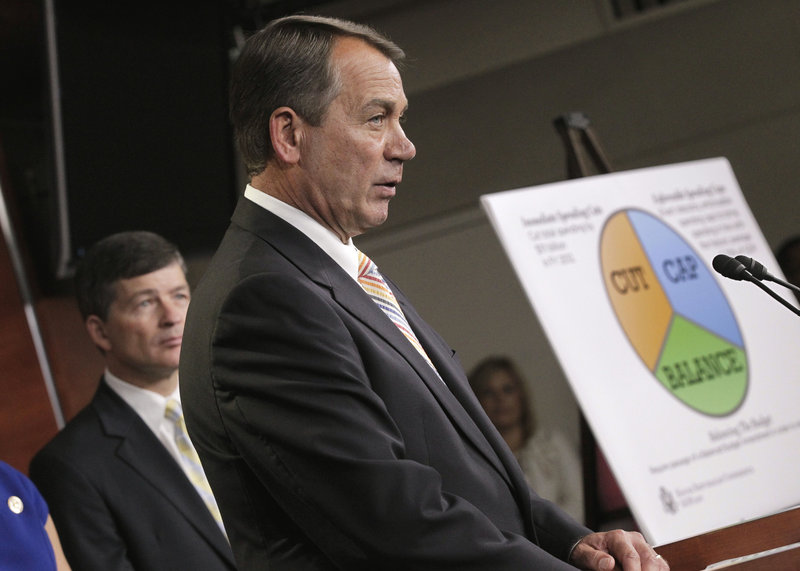A bipartisan Senate plan to cut about $4 trillion from deficits over the next decade emerged as a possible debt-reduction compromise Tuesday, as President Obama touted the ideas as “broadly consistent with the approach that I’ve urged.”
But while Obama’s push gave new momentum to a deal to cut spending and raise the nation’s $14.3 trillion debt limit, a final agreement remained elusive.
Determined Republicans in the House of Representatives won approval, 234-190, of a conservative plan to slash federal spending dramatically. But their “cut, cap and balance” plan won’t become law since the Democratic-led Senate won’t go along, and even if it did, Obama has vowed to veto it.
In the Senate, Majority Leader Harry Reid, D-Nev., wouldn’t endorse the complete $4 trillion package crafted by the so-called “Gang of Six,” saying he wanted to see more specifics. He warned that there’s probably not enough time to adopt such an ambitious plan before the Aug. 2 deadline to raise the federal debt ceiling or force the government into default.
“I’m happy to work and use anything in the Gang of Six that we can, but remember, we only have 13 days,” Reid said.
If the debt ceiling is not raised by Aug. 2, the government will run out of borrowing authority, possibly panicking global financial markets and kicking the frail U.S. economy back into recession. House Republicans insist that they would raise the debt ceiling only if Congress first passes deep cuts in future federal spending and approves an amendment to the Constitution mandating that future federal budgets must balance.
Nonetheless, there were two promising developments Tuesday: an Obama pledge to revive White House bipartisan budget talks, possibly as soon as today, and his nod to the Gang of Six’s work. The bipartisan group met earlier this year seeking consensus on a deficit reduction plan, disbanded in May, then reconvened Tuesday with about 40 senators from both parties.
Details remained vague, but indications were that their plan would raise about $1.2 trillion in revenue over the next decade, satisfying many Democrats, while reducing spending for Medicare and Medicaid, pleasing many Republicans. Broad tax reform would end loopholes while lowering tax rates. Separately, Social Security would be restructured to stabilize its finances for 75 years.
Obama, while acknowledging he’s not yet reviewed the plan, nonetheless called it “balanced,” adding that “it would not match perfectly with some of the approaches that we’ve taken, but I think that we’re in the same playing field.”
Senators from both parties hailed the plan.
Sen. Lamar Alexander of Tennessee, chairman of the Republican caucus, endorsed it, noting that three Gang of Six Republicans are staunch conservatives.
“If they study something for six months (and) tell me it’s good for the country, that means a lot to me,” Alexander said.
Many Democrats also rallied around the plan.
“I would support this plan if it were considered on the Senate floor,” said Sen. Michael Bennet, D-Colo.
Senate leaders were more circumspect. Reid and Senate Republican leader Mitch McConnell of Kentucky have spent days trying to craft their own, more modest approach to raise the debt limit in stages while deferring serious deficit reduction.
Obama on Tuesday said their less ambitious “fail-safe” plan “continues to be a necessary approach to put forward, in the event we don’t get an agreement.”
Logistically, enacting the entire Gang of Six plan before Aug. 2 would be virtually impossible. The nonpartisan Congressional Budget Office has to review and analyze any legislation, which can take days, and Senate procedural hurdles can also take days to overcome.
Even if the Senate passed the Gang of Six proposal, then there’s the Republican-led House, which has made clear that it will not vote for any plan that raises revenues.
Michael Steel, spokesman for House Speaker John Boehner of Ohio, said the Gang of Six plan “shares many similarities with the framework the speaker discussed with the president, but also appears to fall short in some important areas.” Republicans want more savings immediately, more consequences for not achieving desired cuts and more structural changes to Medicare and Medicaid that go further than the Gang of Six has discussed.
On Tuesday, House Republicans were adamantly behind their cut, cap and balance plan.
“The president continues to say that he wants to do big things. We do as well,” said House Majority Leader Eric Cantor, R-Va.
Democrats charged Republicans were doing nothing.
“We are playing ‘let’s pretend’ on the House floor,” said House Democratic Whip Steny Hoyer of Maryland.
The cut, cap and balance plan would slash $111 billion from spending next year. It would scale back spending to not more than 22.5 percent of gross domestic product next year – it’s currently about 24 percent – and drop it gradually to 19.9 percent of GDP by 2017.
Under the GOP plan, before the nation’s debt limit could be raised, a balanced budget amendment to the Constitution would have to be adopted, first by a two-thirds majority in each house of Congress – which Senate Democrats won’t allow – and then by three-fourths, or 38, of the states.
While the House has not scheduled a vote on the amendment, the Senate hopes to vote on it later this week – effectively knocking it off the table.
Send questions/comments to the editors.



Success. Please wait for the page to reload. If the page does not reload within 5 seconds, please refresh the page.
Enter your email and password to access comments.
Hi, to comment on stories you must . This profile is in addition to your subscription and website login.
Already have a commenting profile? .
Invalid username/password.
Please check your email to confirm and complete your registration.
Only subscribers are eligible to post comments. Please subscribe or login first for digital access. Here’s why.
Use the form below to reset your password. When you've submitted your account email, we will send an email with a reset code.